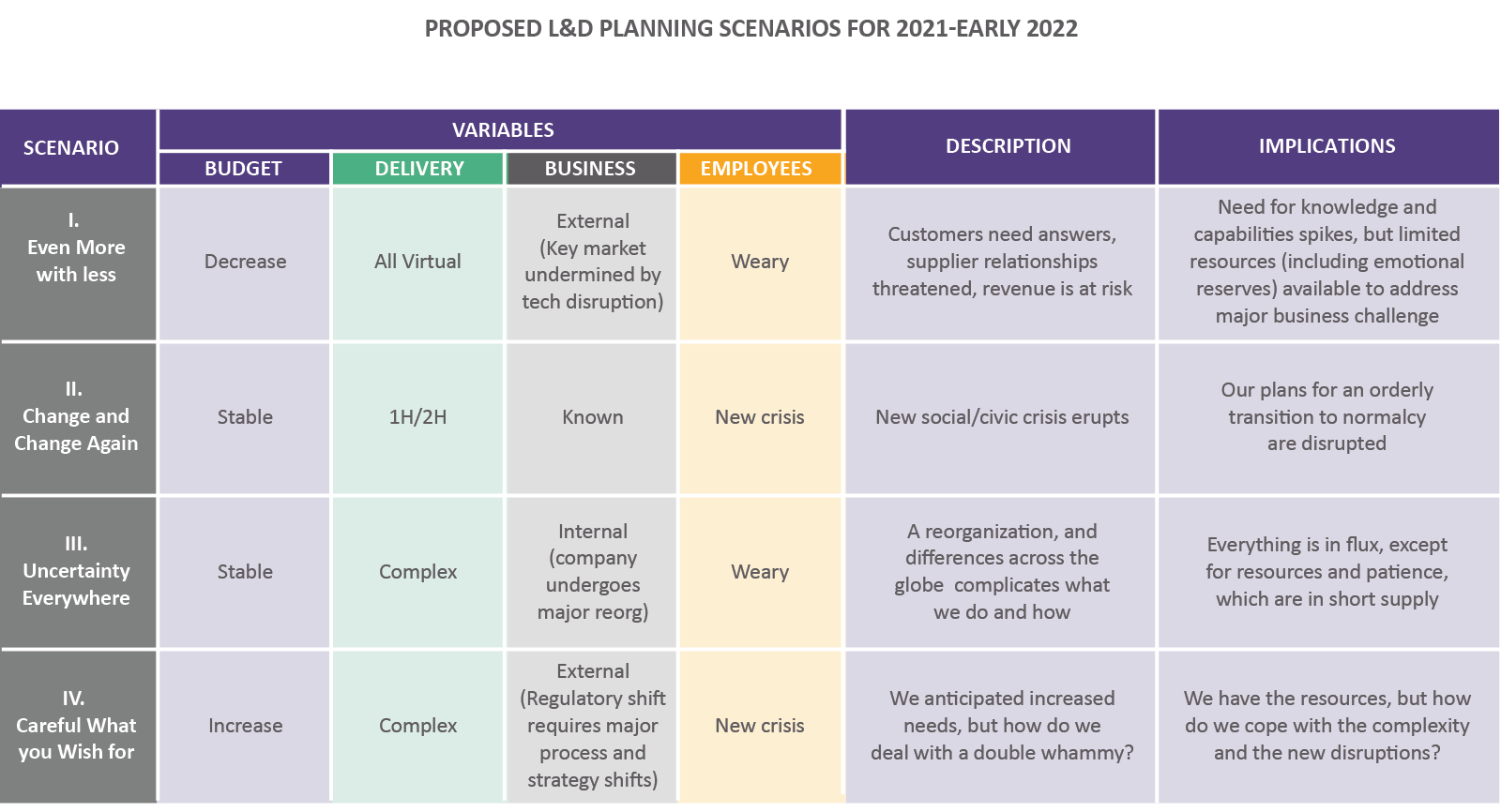A year of pandemic and economic and social disruption firmly established learning and development as a key enabler of organizational resilience, recovery and renewal amid uncertainty. With agility and fortitude, L&D teams:
- Pivoted to virtual to engage anxious learners.
- Helped the business stay engaged with customers, distributors and suppliers, remotely.
- Recognized the need for investments in mental health and self-care.
- Doubled down on developing organizational resilience.
Hard-earned capabilities, built over time by forward-looking L&D leaders, enabled those teams to step up and fill unexpected needs during a critical time. These capabilities were manifest — to the extent that L&D already had invested in virtual capability and digital learning enablement; to the extent that L&D had developed the right channels to and relationships with the business; and to the extent that L&D’s prior efforts to develop “soft skills” enhanced organizational resilience and sustained performance.
L&D leaders face myriad challenges, and some tough choices, as we experience the next stage of what this pandemic has wrought — and foresee the beginning of the end of a prolonged period of isolation and economic dislocation. With constrained resources, how do we meet the real and current needs of the business while preparing for what may lie ahead? Scenario planning can help L&D anticipate, recognize and make choices about how to mitigate certain risks and capitalize on certain opportunities. The idea is not to predict, but to prepare for, change.
Scenario planning can be a handy tool for addressing some of the very real doubts swirling in the minds of learning leaders during this time. It’s easy to be paralyzed by the inherent unpredictability of the near and medium term. What if we invest more in virtual training technology, and then everyone opts for face-to-face? What happens if — after we develop new curricula around empathy and inclusion, and invest in self-care and mental health — our budgets get slashed? What if we ramp up our internal capabilities to deliver training, only to face significant head-count reductions due to market conditions?
The scenario planning process starts with an understanding of the situation and the environment. Define the current state: Who are the stakeholders, what are the competing priorities, where are the possible land mines? Then define the variables most likely to impact the outcomes we are focused on. We can, for example, anticipate that head count, budgets and the ability to commit resources will be impacted by an economic downturn. Some business models will be permanently disrupted — but which ones, and how? What will the work look like, domestically and across the globe, as the pandemic recedes? How will civil society and body politic respond, in the U.S. and elsewhere?
These variables enable us to create possible scenarios to explore. For our Winter 2021 Learning Lab on February 23, which consisted of a scenario planning workshop with a virtual community of L&D leaders, we created more than 80 potential L&D scenarios based on four variables. But not all those scenarios are equally plausible, and neither do they lead to significantly different consequences and choices. (We whittled ours down to four that seemed most fruitful to explore in a 90-minute session.)

Then, as we did in our session, further test, assess and refine your scenarios. Employ other tools, as useful, for further analysis — wargaming can anticipate the response of others; decision trees and cost-benefit analysis illuminate the implications of our choices; and contingency analysis can help manage risks and seize opportunities caused by external impacts.
The group of L&D leaders participating in our scenario planning workshop hailed from a dozen industries and from across the U.S., Europe and Southeast Asia. We broke them into small groups to discuss the different scenarios, then reconvened to share strategies for risk mitigation — and for capitalizing on opportunities. Even with this diversity of participants, a few “dominant” strategies surfaced when we looked across the analysis of each scenario. (Dominant strategies are those that seem worth pursuing regardless of which scenario actually comes to pass and are indicative of investments worth making even with significant uncertainty.)
Leadership engagement — not just in defining requirements and budgets, but their presence and role in talent development — rose to the top of the list. When attention spans are limited and distraction factors are high, it speaks volumes to see leaders directly involved in learning. Learning also can be a crucial enabler for the top of the house: “Let senior leaders know they can speed dial us and have that one-on-one conversation,” noted one L&D leader in our session.
Flexibility also came to the forefront. That’s not about “keeping our powder dry until we know.” Rather, in these scenarios, enabling flexibility meant investing in hybrid delivery channels and opting for more bite-sized training — which one of our discussion groups considered a silver lining in the shift to virtual.
Creating more digestible chunks to learn relates to another dominant strategy our group discussed: improving our capabilities to engage learners, even in the absence of traditional “high-touch” opportunities. During the pandemic, L&D stepped up in the area of mental health; participants talked about IT groups that had sent out tech-related “care packages” and how marketing could help by turning some of its capabilities internally. It’s crucial to continue exploring how to reach individual learners and engage and coach teams in new ways.
We can’t afford to do everything, but how can we handle the good ideas, that aren’t top priorities — but that we don’t want to discard, either? “Take the first few steps along a path,” suggested one learning executive. “Put a better plan in place at an outline level. Park the plan until needed, and then you are one step ahead at low cost.”
Uncertainty can’t mean “we do nothing until we know.” By then, it’s too late to build what we needed to have to respond to the change. Instead, using a tool such as scenario planning, L&D leaders can anticipate and consider what we would do if X or Y came to pass, and what enablers or capabilities would be required to mitigate the worst and optimize the best of that situation. We then prioritize among those anticipatory capabilities, asking whether we would regret having invested in them if a particular scenario didn’t come to pass.
We are sure to find more than enough “no regret” investments to make — ones that will leave us better prepared for whatever comes our way.















